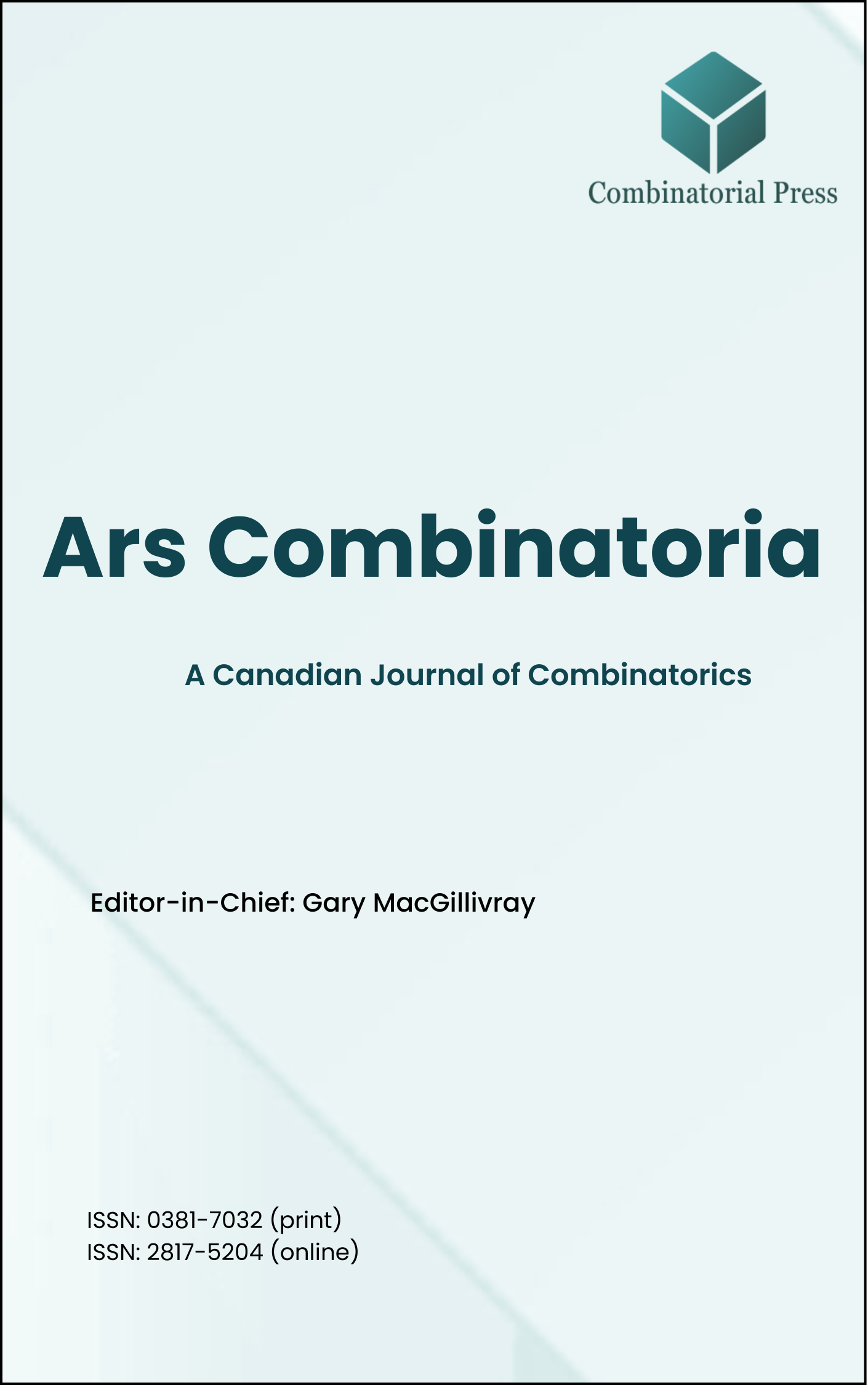
Ars Combinatoria
ISSN 0381-7032 (print), 2817-5204 (online)
Ars Combinatoria is the oldest Canadian Journal of Combinatorics, established in 1976. The journal is dedicated to advancing the field of combinatorial mathematics through the publication of high-quality research papers. From 2024 onward, it publishes four volumes per year in March, June, September and December. Ars Combinatoria has gained recognition and visibility in the academic community and is indexed in renowned databases such as MathSciNet, Zentralblatt, and Scopus. The Scope of the journal includes Graph theory, Design theory, Extremal combinatorics, Enumeration, Algebraic combinatorics, Combinatorial optimization, Ramsey theory, Automorphism groups, Coding theory, Finite geometries, Chemical graph theory but not limited.
Information Menu
- Research article
- Full Text
- Ars Combinatoria
- Volume 030
- Pages: 193-202
- Published: 31/12/1990
The point set “oval” has been considered in Steiner triple systems \((STS)\) and Steiner quadruple systems \((SQS)\) [3],[2]. There are many papers about “subsystems” in \(STS\) and \(SQS\). Generalizing and modifying the terms “oval” and “subsystem” we define the special point sets “near-oval” and “near-system” in Steiner quadruple systems. Considering some properties of these special point sets we specify how to construct \(SQS\) with near-ovals (\(S^{no}\)) and with near-systems (\(S^{ns}\)), respectively. For the same order of the starting system we obtain non-isomorphic systems \(S^{no}\) and \(S^{ns}\).
- Research article
- Full Text
- Ars Combinatoria
- Volume 030
- Pages: 177-191
- Published: 31/12/1990
P. Paulraja recently showed that if every edge of a graph \(G\) lies in a cycle of length at most \(5\) and if \(G\) has no induced \(K_{i,s}\) as a subgraph, then \(G\) has a spanning closed trail. We use a weaker hypothesis to obtain a stronger conclusion. We also give a related sufficient condition for the existence of a closed trail in \(G\) that contains at least one end of each edge of \(G\).
- Research article
- Full Text
- Ars Combinatoria
- Volume 030
- Pages: 97-140
- Published: 31/12/1990
- Research article
- Full Text
- Ars Combinatoria
- Volume 030
- Pages: 50-64
- Published: 31/12/1990
Let \(G\) be a \(p\)-vertex graph which is rooted at \(x\). Informally, the rotation number \(h(G, x)\) is the smallest number of edges in a \(p\)-vertex graph \(F\) such that, for every vertex \(y\) of \(F\), there is a copy of \(G\) in \(F\) with \(x\) at \(y\). In this article, we consider rotation numbers for the generalized star graph consisting of \(k\) paths of length \(n\), all of which have a common endvertex, rooted at a vertex adjacent to the centre. In particular, if \(k = 3\) we determine the rotation numbers to within \(1, 2\) or \(3\) depending on the residue of \(n\) modulo \(6\).
- Research article
- Full Text
- Ars Combinatoria
- Volume 030
- Pages: 33-49
- Published: 31/12/1990
The paper deals with combinatorial structures (pseudo-complexes, crystallizations) giving a direct link between the topology of triangulated manifolds and the theory of edge-coloured multigraphs. We define the concept of regular crystallization of a manifold and prove that every non-trivial handle-free closed \(n\)-manifold has a regular crystallization. Then we study some applications of regular crystallizations and give a counter-example to a conjecture of Y. Tsukui [20] about strong frames of the \(3\)-sphere.
- Research article
- Full Text
- Ars Combinatoria
- Volume 030
- Pages: 23-26
- Published: 31/12/1990
A construction is given of a family of D-optimal designs of order \(n = 2v \equiv 2 \pmod{4}\), where \(v = 2q^2 + 2q + 1\) and \(q\) is an odd prime power. For \(q > 3\), all the orders of D-optimal designs produced by this construction are new.
- Research article
- Full Text
- Ars Combinatoria
- Volume 030
- Pages: 13-22
- Published: 31/12/1990
The set of all distinct blocks of an \(t\)-(v,k) design is referred to as the support of the design, and its cardinality is denoted by \(b^*\). By generalizing a method on BIB designs called “trade off” to \(3\)-designs, a table for \(3\)-(9,4) designs with each \(60 \leq b^* \leq 126 = {\binom{9}{4}}\) is constructed. Also, we have produced over 2500 non-isomorphic \(3\)-(9,4) designs with \(\lambda = 6\). By utilizing this generalized trade off method along with two other methods, a table for \(3\)-(10,4) designs with 156 different \(b^*\)’s is constructed. By a recursive lower bound on the minimum value of \(b^*\) in all \(t\)-(v,k) designs, it is shown that \(b^*_{min}[3-(9,4)] \geq 36,\) and \(b^*_{min}[3\)-(10,4)] = 30.
- Research article
- Full Text
- Ars Combinatoria
- Volume 030
- Pages: 3-12
- Published: 31/12/1990
A hypergraph has property \(\mathcal{B}\) (or chromatic number two) if there is a set which intersects each of its edges, but contains none of its edges. The number of edges in a smallest \(n\)-graph which does not have property \(\mathcal{B}\) is denoted \(m(n)\). This function has proved difficult to evaluate for \(n > 3\). As a consequence, several refinements and variations of the function \(m\) have been studied. In this paper, we describe an effort to construct, via computer, hypergraphs that improve current estimates of such functions.
- Research article
- Full Text
- Ars Combinatoria
- Volume 030
- Pages: 161-176
- Published: 31/12/1990
We complete the construction of all the simple graphs with at most \(26\) vertices and transitive automorphism group. The transitive graphs with up to \(19\) vertices were earlier constructed by McKay , and the transitive graphs with \(24\) vertices by Praeger and Royle . Although most of the construction was done by computer, a substantial preparation was necessary. Some of this theory may be of independent interest.





